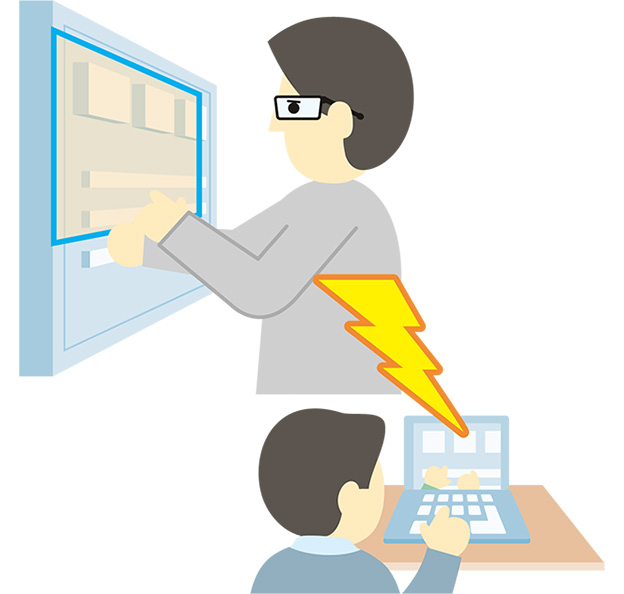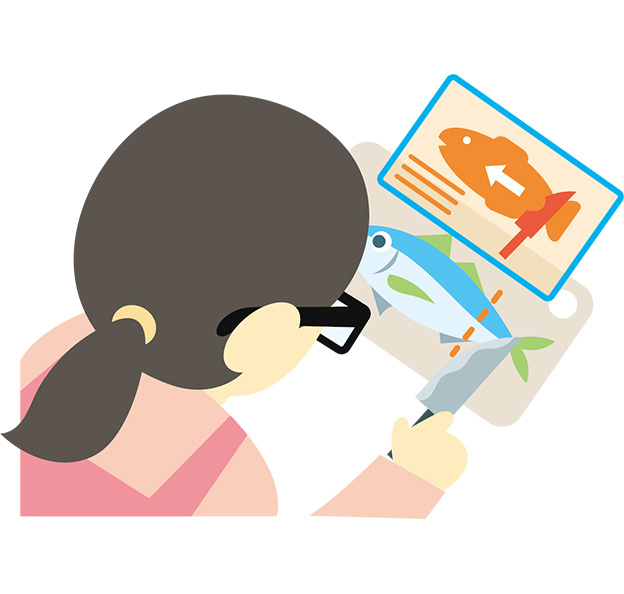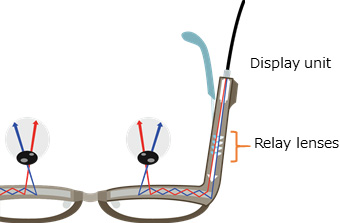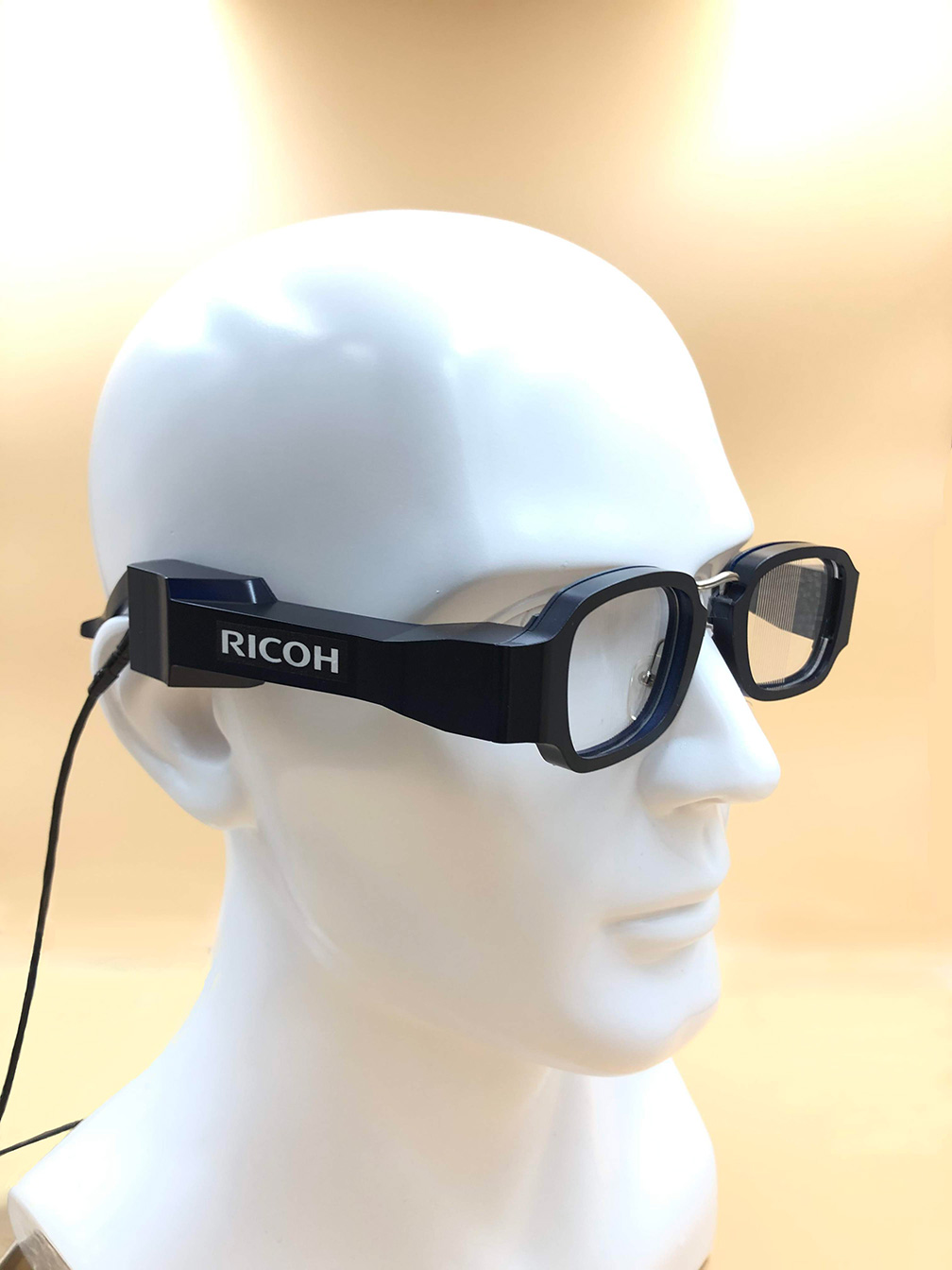- Home
- Ricoh's Technology
- Smart Glasses
Smart Glasses
Background
Binocular smart glasses, which are glasses-type wearable terminals, that work with PCs and smartphones to overlay digital information on the wearer's field of view (hereafter called “smart glasses”). These have a wide range of potential applications—for example, providing work instructions for medical personnel, construction workers, and manufacturing. They can also be used to provide navigation assistance for the general public. Conventional binocular smart glasses typically weigh three times more than ordinary glasses and are primarily intended to assist remote work for short periods. To meet the needs of general tasks in offices, shops, and manufacturing, as well as the general public, the technology essential for smart glasses must provide a wide field of view that accommodates displaying adequate information while being light enough to wear all day.
Solution
We developed a smart glasses technology by paying particular attention to how the finished product looks in terms of design, as well as making sure it is lightweight so that one can wear them for a long time.
These smart glasses have a diverse range of applications, everything from everyday living to business use.
- Sharing what the wearer sees
Create richer communications by sharing exact video footage of what the wearer is viewing.
- Linking reality to information
Display additional information to for use in a range of applications from supporting daily living to augmented reality in games and other digital services.
- Making information smarter
Users can share and view additional information privately in order to avoid disrupting presentations and conversations.



Technical Highlight
1. Wide screen, yet lightweight
In traditional binocular smart glasses, the light guide plate used in the lenses were significantly heavier due to the thickness of the glass, or multiple glass plates being used, or the associated hardware required to obtain a wide screen viewable area.
Ricoh's smart glasses use an originally developed plastic light guide plate. This light guide plate has multiple fine mirror structures on its surface, and the image on the display is reflected by each mirror and delivered to the eye. This allows a wide field of view equivalent to a 30-inch screen installed 1 meter away from a single thin plastic structure. Another feature is that the plastic microstructure can be mass-produced at low cost using injection molding.
2. Balanced and comfortable
In conventional smart glasses, the light guide plate and the display are integrated, and most of the weight is concentrated on the lens. Therefore, the problem was that weight was primarily on the nose and could not be worn for long periods of time.
Ricoh has developed a special optical system that uses relay lenses and places the display unit near the temples. The display image on the display unit is reproduced on the light guide plate by passing through relay lenses. By shrinking the display unit and placing it near the temples, and using thin lenses, the weight balance between the front and rear of the smart glasses is almost the same, and the load on the nose is reduced to the same level as general eyewear. With this technology, users can wear the smart glasses comfortably for a long time.

3. It also looks smart
Ricoh collaborated with an eyeglass manufacturer to create a simple, uncomplicated design that is similar to everyday eyewear. We were also able to shrink the display unit design and lenses to make them comfortable to wear all day.

4. Adaptable to various applications
Ricoh's smart glasses display images in front of the eye by connecting a smartphone or PC. The smart glasses can display applications from the screen of a smartphone or PC. They can also open development of new applications specifically for smart glasses using standard platforms.
Also, a 9DOF* (acceleration, angular velocity, geomagnetism) sensor is installed as standard. By detecting the head's movement, it can be set to display an image only at certain times, for example when looking down, or give appropriate directions by detecting the orientation the wearer is walking. By attaching a camera or depth sensor as an option, it can also support AR (Augmented Reality).
- *
- DOF: degree-of-freedom
Ricoh's vision
Ricoh has produced many optical products, such as projectors and cameras, using precise optical technology. By combining these optical technologies, optimizing the display unit and the light guide plate, we have produced smart glasses that are both compact and lightweight and have a wide display screen.
The new technology will free users from the restrictions of place and wearing discomfort, giving access to needed information anytime and anywhere. By uniting the real world with digital information, Ricoh continues to provide its customers with valuable digital services while developing innovative products and solutions for various workplaces and lifestyles.
- *
- This technology will be presented at the SID Display Week 2020 Symposium on August 5, 2020.
Related Information
Sorted by : field “Sensing”